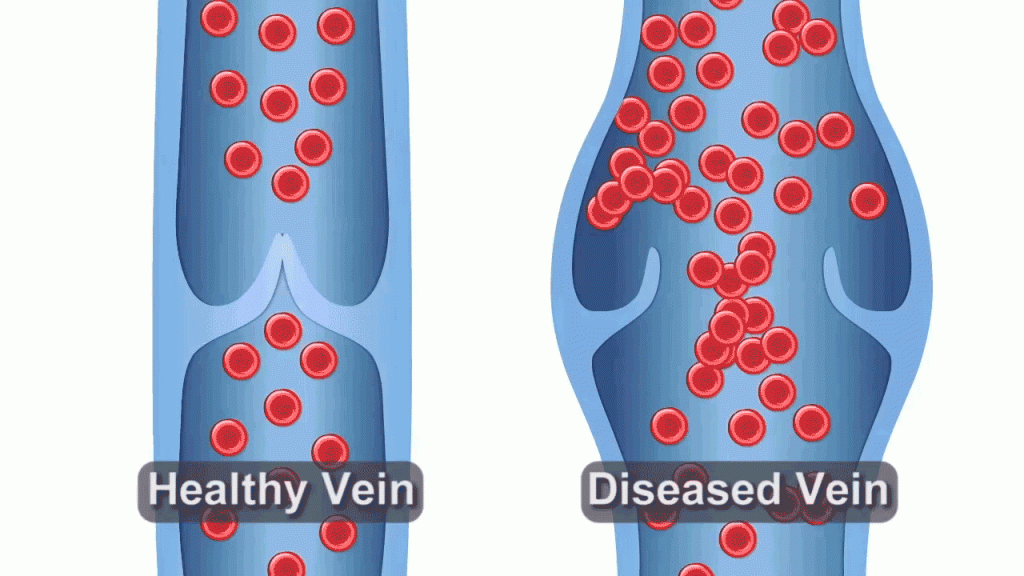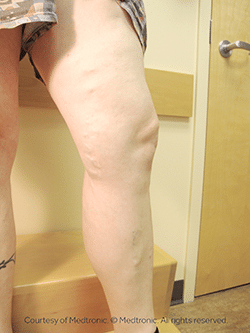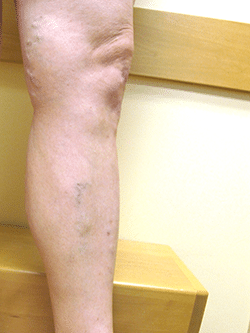Vein/Venous Diseases
The veins in your legs carry blood back to your heart. The veins have one-way valves that keep blood from flowing backward. These valves are especially important in your legs as your blood is flowing upward against gravity.
If the valves don’t work to close properly which inhibits your blood flow and can allow blood to leak back and get stuck in part of a vein. This is a condition called “venous reflux”. As this blood pools in your lower legs, your vein swells and a varicose vein develops. This leads to Chronic Venous Insufficiency (CVI).
Over time, CVI can cause pain, heaviness or fatigue, swelling, and skin changes in your legs. It may also lead to open sores (venous ulcers) on your legs. Symptoms can worsen over time if left untreated.

What are Varicose Veins?
Varicose veins are bulging veins usually affecting the lower leg and upper thigh. The veins start to bulge as a result from the valves not working properly and blood starts to pool in the lower legs.
Varicose veins and venous insufficiency cause fluid retention, bringing about leg pain, heaviness and swelling (edema). When your blood doesn’t flow back to your heart efficiently, you’re more likely to develop edema, which also causes swelling, cramping, pain and fatigue in your legs.
Varicose veins are often misunderstood as simply a cosmetic issue, but when left untreated, they can progress into a more serious condition called chronic venous insufficiency (CVI).
What is Vein Thrombosis?
Vein thrombosis often called Deep Vein Thrombosis (DVT), is a condition where a blood clot (a thrombus) develops in one of your veins. The clot can impede blood flow back to your heart and lead to fluid retention, swelling, and pain. DVT develops after extended periods of not moving – such as long airplane trips or if you’re bedridden after an injury or surgery.
How are Venous Diseases and Disorders diagnosed and treated?
Venous diseases and disorders are usually diagnosed with a simple Ultrasound Duplex study of your legs.
The goal of treatment for vein disease is to reduce or stop the backward flow of blood. By closing down the problem vein(s), the blood flow is diverted to nearby healthy veins.
The providers at San Tan Cardiovascular Center can help you decide which treatment is best for you:
- Compression stockings (“Conservative” treatment)
- Closing diseased vein (Ablation procedure)
If conservative treatment measures (compression stockings) have failed to relieve symptoms, your Provider might suggest a Venous Ablation procedure to close down the vein. Every patient is unique, and so is every treatment plan.
| Before Ablation Procedure | After Ablation Procedure |
 |
 |
| Before Albation Procedure | After Ablation Procedure |
 |
 |
San Tan Cardiovascular Center will customize a treatment plan based on your needs, your condition and your insurance plan.
Treatment for Venous Diseases at San Tan Cardiovascular Center
How do I get started?
Contact San Tan Cardiovascular Center today to make an appointment with one of our healthcare providers.
At this appointment:
- we will review your medical history, discuss your symptoms and perform a non-invasive, diagnostic test to further determine your medical condition,
- any pertinent testing that needs to be done beforehand will also be ordered at this time.
Our billing department will then contact your health insurance company to obtain prior authorization. Upon receiving insurance authorization, the procedure will be scheduled.
Venous Diseases FAQs
Q: What are the risk factors for Venous conditions?
- Obese
- Over age 50
- Pregnant or have been pregnant more than once
- Have a family history of CVI or varicose veins
- Someone with history of blood clots
- A smoker
- Weightlifters
- Prolonged standing
Q: How prevalent is Chronic Venous Insufficiency?
- Varicose veins are most common in women (75 percent of those diagnosed) than in men (25 percent of those diagnosed).
- More than 190 million people have CVI or varicose veins globally. In the U.S., more than 30 million Americans suffer from varicose veins, or CVI, yet the majority remains undiagnosed and untreated.
- Varicose veins, a common symptom of CVI, can affect up to 40% of adults.
- Up to 55 percent of American women may be affected by varicose veins in their lifetime.
- It is common for varicose veins to become more prominent during pregnancy and worsen with successive pregnancies.
The healthcare providers at San Tan Cardiovascular will exam your legs, symptoms and medical records to see if you are at risk for any venous conditions.
Q: How can I prevent Chronic Venous Insufficiency?
- Eat a healthy balanced diet.
- Quit smoking.
- Exercise regularly.
- Avoid wearing restrictive clothing such as tight girdles or belts.
- Lose weight if you are overweight.
- Avoid prolonged sitting or standing.
Q: What are the symptoms of Venous Diseases or problems?
- Swelling
- Heavy or tired legs
- Achiness
- Pain
- Itchiness
- Cramping
- Burning
- Varicose veins (twisted, enlarged veins close to the surface of the skin)
- Discoloration of lower legs
- Ulcers (wounds) on legs or feet
With proper treatment, the progressive symptoms of vein disease are preventable.
Without treatment, signs and symptoms may progress and significantly impact quality of life, and lead to venous leg ulcers.